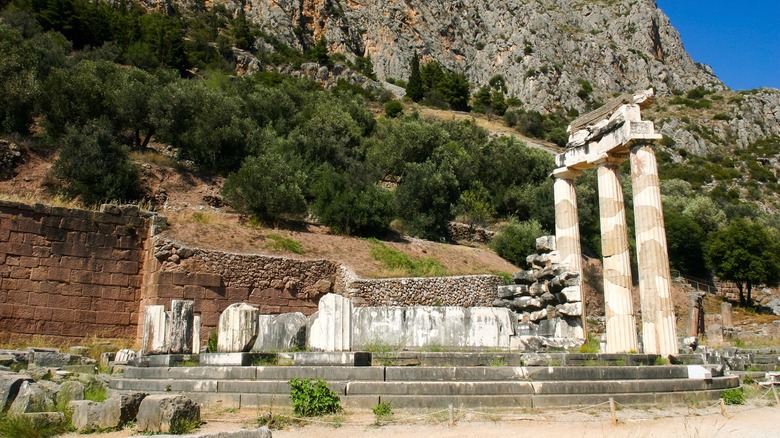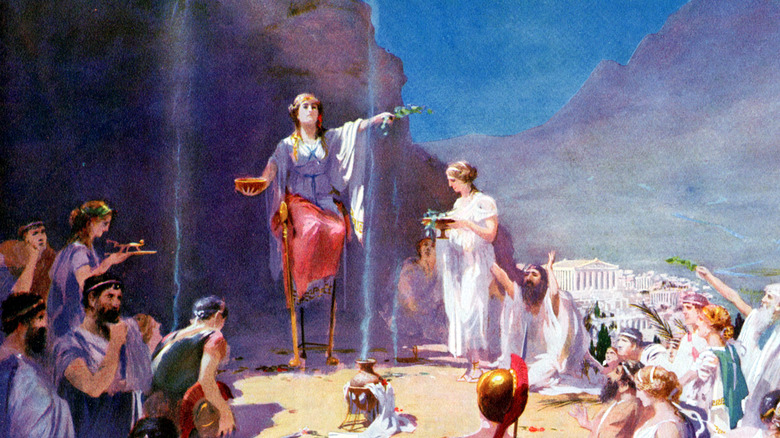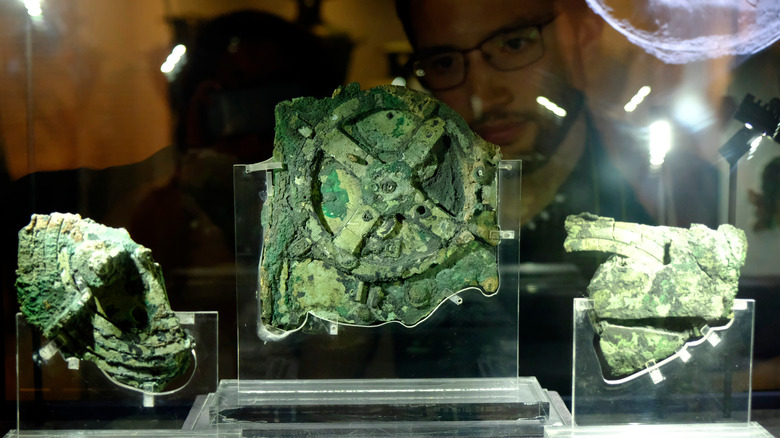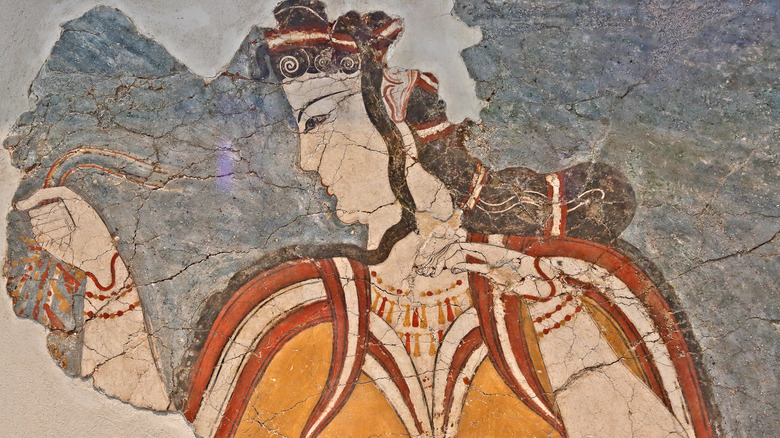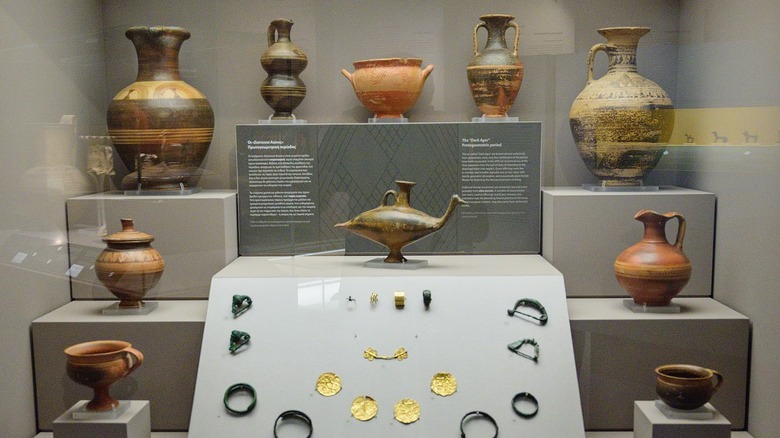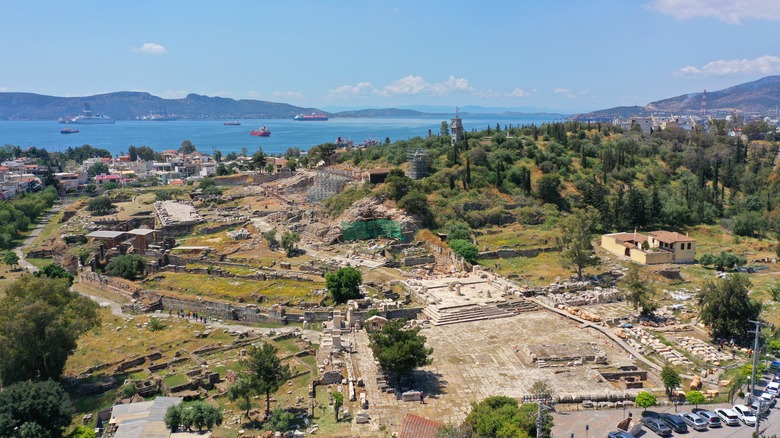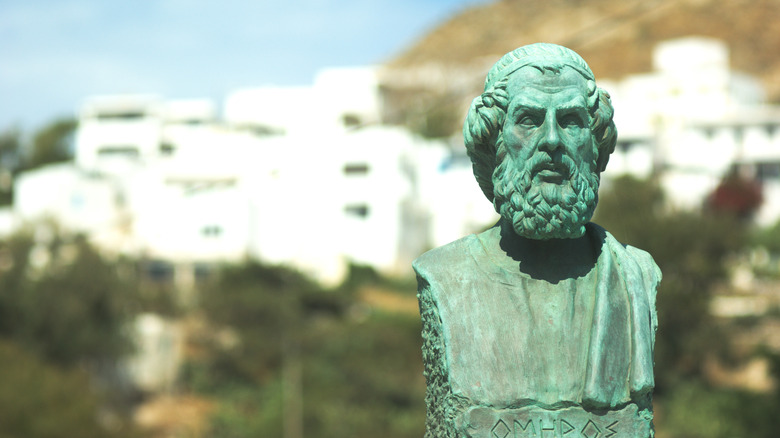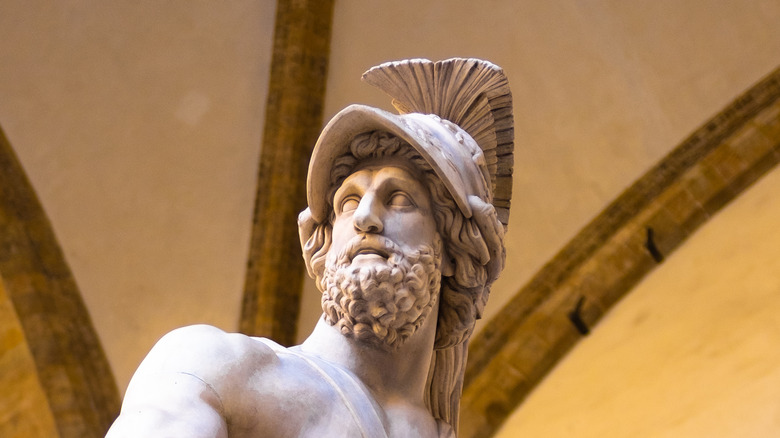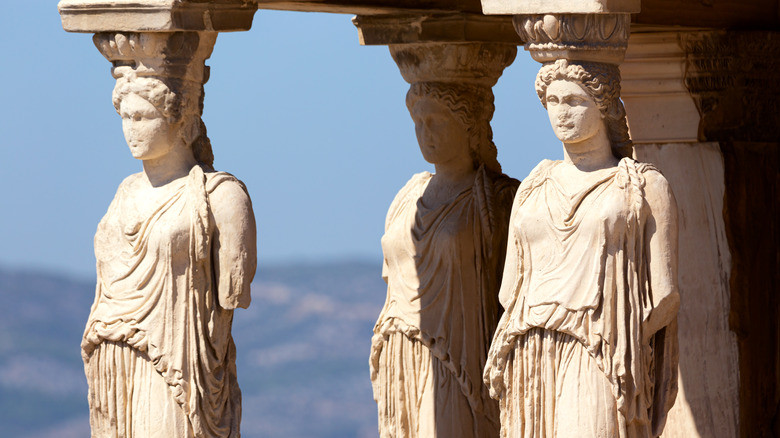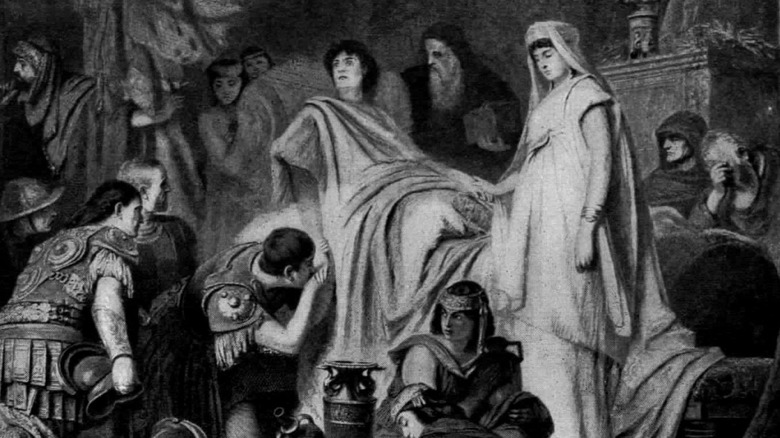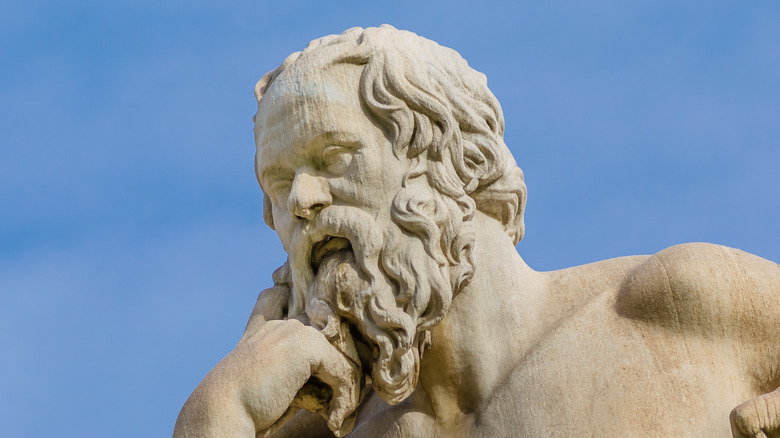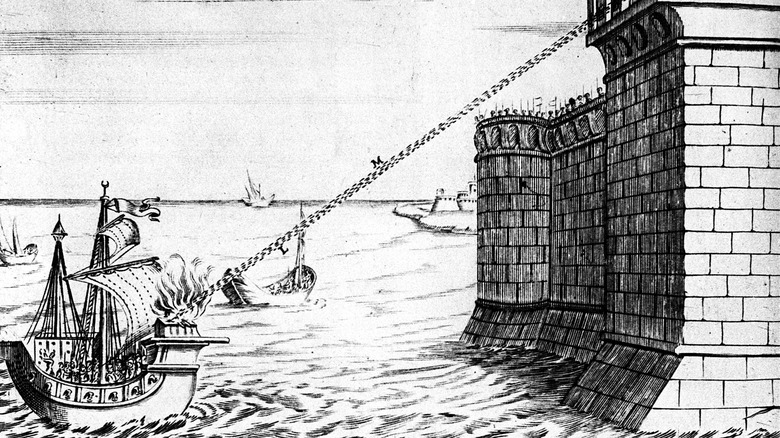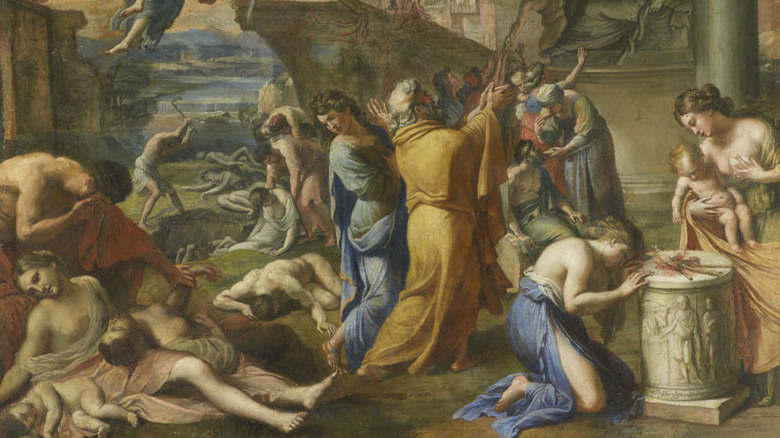Ancient Greek Mysteries People Are Still Trying To Solve
The ancient Greeks are known for creating the underpinnings of Western civilization. From the Parthenon to the Olympics to the movie "300," the Greeks are known for their achievements in philosophy, thought, literature, and science. Yet for all of that, Greek civilization was such a long time ago that there are still mysteries that no scholar has been or will be able to resolve satisfactorily until the invention of a time machine. Think about it. Work on the Parthenon began in 447 B.C.E. If you think misinformation is bad today, imagine what is lost in translation when two and a half millennia have passed.
Some of what isn't known about the ancient Greeks involve some very famous people and even some gods. Ultimately, these mysteries have created puzzles that scholars and laymen alike have spent countless hours without much hope for an answer — but nevertheless they are fun to speculate upon and make for good dissertation fodder. Perhaps William Shakespeare put it best in "Julius Caesar," when the character Casca expressed his lack understanding when he said, "It was Greek to me."
What put the Oracle at Delphi into a trance?
When people need advice or predictions today you may consult a toy 8-ball. In ancient Greece, one would trudge to the Oracle at Delphi where the priestess, called the Pythia, gave strange predictions through utterances while in a trance. Of all the mysteries of the mysterious Oracle, the most puzzling is how the Pythia entered into these helter-skelter states. Several theories have been cast about over the centuries, which included chewing laurel leaves (they are not hallucinogenics) and spiked spring water.
Another longtime theory was that priestesses were subject to intoxicating gases rising from fissures within the rock, which is recorded in ancient written sources. However, no such fissures have been found, and the theory was tossed as bunk with the rest of the speculations. However, in the early 21st century the gas-theory gained some traction as the Journal of Toxicology published research that found traces of ethylene at the site — a gas used in anesthesia. This theory has been criticized by other scholarship such as that found in the journal Clinical Toxicology. One obvious flaw in the theory is that the supplicants never became affected by gas even though they were in the presence of the Pythia. This goes to show that old bunk gets easily recycled.
What was the origin of the Antikythera mechanism?
In 1901, archaeologists were excavating the remains of a first century B.C.E. Greek shipwreck near the island of Antikythera when they uncovered a most puzzling artifact. Composed of gears and dials, it was roughly the size of the shoebox and the most complex mechanism ever discovered from the ancient world. The symbols and devices on it made it clear it was used for astronomical purposes, but it was unclear exactly how since only a third of it survived the tumults of history. Even after major breakthroughs with examinations by x-ray in the early 21st century showed that it was also used to predict eclipses, the Antikythera mechanism still has many mysteries surrounding it that continue to fascinate. Heck, researchers have even created a working LEGO version of the thing in an attempt to figure it out.
Perhaps the greatest unanswered question of the Antikythera mechanism is that even though it is thought it could be used to make astronomical predictions, its exact use is unknown. It is also not known who made the thing, though such devices are mentioned in the surviving historical literature. There is wild speculation, which occasionally hits the media, such as a recent article in Scientific American by one of the researchers from the University of London who claims the great mathematician and engineer Archimedes made the thing himself, although it is admitted that there is no evidence to support it.
Why did Mycenaean civilization collapsed?
In the late Bronze Age, from 1700 to 1100 B.C.E. the Mycenaean civilization dominated Greece. Featuring large cities and impressive artifacts, it had a direct influence on later Greek civilization. Despite its power and its prosperity, this society started to collapse beginning in about the year 1230 B.C.E. It pretty much completely imploded by 1100 B.C.E. One of the great challenges facing archaeologists is to figure out what happened.
Unfortunately, it seems that the answers can only be speculative, and each theory is mainly conjecture based on some evidence. Some have proposed overpopulation, others disasters such as earthquakes, and still others invasions. Each of these theories can be as valid as the next, or maybe it is a combination of all of the above. In fact, the fall of the Mycenaeans coincided with the much wider destruction of many of the great Bronze Age civilizations of the time. The cause of the death of these civilization is one of the great puzzles of history, though it is suspected that the great civilizations such as the Mycenaenaeans were interdependent with other civilizations so that when one suffered collapsed, the others followed.
What really happened during the Greek Dark Ages?
If the mystery of the Mycenaean collapse is puzzling, trying to figure out what happened after is an complete enigma. With the end of Mycenaean hegemony, Greece entered a four-century period from 1200 to 800 B.C.E. known as the Greek Dark Ages. As may be imagined from the era's title, not much is known about the time. Writing was nil so everything that is known of the period is based on archaeological remains. In fact, most historians can't agree on a start or end date for the Greek Dark Ages.
For the people who lived through this period it would be akin to living in a post-apocalyptic world where you see great ruins all about you. You know that the people before you had great technology, but you had little understanding of it. At least this was the traditional view of many scholars in the past. However, recent work on the period has shed more light on conditions through the period, including the fact that they had been developing more sophisticated pottery as well as forging iron. In fact, some authors take umbrage at the term "Dark Age" since it implies an age of barbarity where nothing is known. Still, all signs point to a period of societal collapse with depressed populations, lack of urban centers, and decentralized governments. It just sounds like a time you wouldn't want to live and one that will remain a mystery.
|Featured image by Zde via Wikimedia Commons|cropped and scaled|CC BY-SA 4.0|
What were the rituals of the Eleusinian mysteries?
Ancient Greek religion was polytheistic — one aspect of which was the worship of individual gods in different cult practices. One of these was the Eleusinian Mysteries. This cult consisted of secret religious rites conducted at the site of Eleusis in honor of the goddess Demeter and her relationship to her daughter Persephone. What is known about this mystery religion is what the public would see. Rituals were conducted twice a year. Participants drank a beverage that may have had a psychedelic effect. They then entered a building called the Telesterion where a secret ritual took place.
Nobody knows what happened during the ritual. Writings after the fact note how people were changed after them, meaning that there was some sort of spiritual experience, but there is no detail about them. Whether people went through a hazing ritual or experienced a spirit quest is completely unknown. Whatsoever the case, the Eleusinian Mysteries were very popular in ancient Greece with almost every prominent writer, including Plato, taking part in them. The shame is that none of these writers wrote any detail about the ritual itself. This may be since participants were sworn to secrecy. To add a little more teeth enforcing the secret, certain cities, such as Athens, imposed death upon those who talked.
Was Homer a real person?
Homer is the name of the poet credited with writing the Greek epic poems, "The Iliad" and "The Odyssey." Among the Greeks, he was thought to be an old, blind man who created his works maybe as far back as the seventh century B.C.E. In fact, some ancient people held that they were the bard's descendants calling themselves the "Homeridae" who preserved his poetry. Ancient Greek authors when writing about Homer treated him as a real historical figure but were always sort of hazy on the dates.
The problem is that there is no concrete historical evidence for a person named Homer even though the ancient Greeks believed he existed. This has led to a number of modern theories as to who or what Homer was. Each conjecture is seemingly as valid as the next. For example, some have thought Homer was really a woman. Others have suggested it might have been an order of poets rather than a single person, which plays in well to the notion of a group calling themselves the Homeridae, or "children of Homer." Some of the content of the poems seems to show they may be the folklore of an earlier age, from before the Mycenaean collapse. Perhaps Homer was merely the editor of a long tradition of ancient epic poetry. Without a time machine, the truth will remain a mystery.
Were Homer's poems based on real events?
Speaking of Homer, one of the greatest mysteries of ancient Greece was the historical reality of the Homeric epics. "The Iliad" and "The Odyssey" are tales of and after the Trojan War and include the gods such as Zeus, Poseidon, and Athena, as well as heroes such as Achilles and Odysseus. While obviously there are mythological elements to the stories, is there any historic reality? Did the Greeks truly fight an epic war against the city of Troy?
This subject has been debated for centuries. The prevailing wisdom until the 19th century was that these tales were purely fantastical myths. That was the case until the amateur German archaeologist Heinrich Schliemann, who believed Homer's stories as literal, discovered the ruins of Troy on the coast of Turkey in the 1870s. This discovery and subsequent archeological research has shown that there might have been a war in the late Bronze Age between the Mycenaeans and the Hittites. However, it is impossible to know what level of detail from the narrative may or may not have occurred.
What happened to the statues of Phidias?
Some of the greatest works of Greek art and architecture were created by the renowned Phidias. Many tourists today go to see the remains of his work on Athens's acropolis, including the famed Parthenon. But Phidias was most widely praised as a sculptor. What were considered his greatest works were the statue of Athena Parthenos that sat in the center of the Parthenon and the colossal statue of Zeus at Olympia. This latter work became known as one of the Seven Wonders of the World in antiquity and became iconic, being featured in art and upon coinage.
Sadly, at some point within history both of these monumental statues disappeared. Athena Parthenos disappeared in late antiquity. It is supposed to have been hauled off to Constantinople where it may have been destroyed. Another conjecture is that invading tribes may have destroyed or taken it. Nobody will ever know for sure. Likewise, the statue of Zeus was relocated from Olympus to Constantinople in 395 C.E. by the emperor Constantine. It disappeared in the fifth century CE. There are several theories as to what happened, including destruction through earthquake or fire. But it is still unclear what happened.
What caused the death of Alexander the Great?
One of the great mysteries of the ancient Greek world is post-mortem of the Macedonian conqueror Alexander the Great in 323 B.C.E. At just age 32, the warrior king dropped dead after conquering a massive empire. The big mystery is how he died, and scholars have been speculating on it for millennia.
There are many different theories. These range from poisoning to various diseases, such as West Nile encephalitis, as per Emerging Infectious Diseases. The trick for scholars is matching the symptoms as detailed in the historic record with known diseases. This, however, is hardly conclusive. One article in the journal Addiction explores the evidence that the warrior king was a chronic alcoholic and that booze killed him. And still other theories have stated that tainted water did him in.
The grim list goes on and on. In the end, trying to figure this one out is a mystery that will continue to delight historians. After all, trying to conduct an autopsy from a death well over 2,000 years ago without a body is as hard as it sounds.
Who was the real Socrates?
Socrates, as any fan of "Bill and Ted's Excellent Adventure" would know, was an important dude. This Greek philosopher single-handedly established the basis of Western thought. However, he never wrote anything, and nothing about Socrates the person has survived through history. Rather, it's the writings of his student, Plato, and other scholars, that have given credence to the man. This problem, or the "Socratic Problem" as it is called, is that Socrates became an ideal and was treated as that rather than a person with favorite colors and hobbies.
This seemingly intractable problem does not prevent scholars from trying to dissect the three main sources on Socrates: Plato, Xenophon, and Aristophanes. Aside from Plato, who used Socrates as a philosophic ideal in his dialogues, Xenophon only has a mention of how inquisitive he was while Aristophanes, as a playwright, used him as a character. It is hardly enough information to create an online dating profile. Unless some new ancient text emerges, it is evident that the Socratic Problem will remain an intractable problem.
What exactly was Archimedes sci-fi death beam?
One of the most famous of ancient engineers and mathematicians was Archimedes from the Greek colony of Syracuse on the island of Sicily. Archimedes lived during a time when the Roman Republic was expanding to an empire. During the Second Punic War, in 214 B.C.E., Rome launched a campaign against Syracuse. Archimedes then employed his considerable engineering talents to create war machines for his city. For example, he deployed some sort of crane/claw mechanisms, which picked up and smashed Roman ships. It is not clear how these weapons worked, leaving it to scholars to guess.
Another war machine that Archimedes reputedly deployed was a sort of heat beam that sounds more fitting for a "Star Wars" tableaux than the Greco-Roman world. The weapon apparently sent a beam of heat against ship, burning their sails. Ancient writers described "burning-glasses," while later Byzantine writers asserted that it was done through mirrors. The book, "Beam Weapons," notes how modern scholars have debated the weapons existence. One team in the 1970s used mirrors to try to replicate the weapon. During the experiment, 60 people held 3-by-5-feet mirrors. While they were successful and able to set ablaze a ship at a 160-foot distance, it was dismissed by others who couldn't imagine the Greeks would have so many immense mirrors. So while plausible, the debate over Archimedes' weapons will no doubt continue.
What caused the plague of Athens?
The Peloponnesian War was fought in the fifth century B.C.E. between the city states of Athens and Sparta. In an epic war spanning decades, these opponents saw many ups and downs. One of the most severe downs for Athens, which helped lead to its eventual defeat, was a plague that broke out in 430 B.C.E. For historians, one of the greatest mysteries is figuring out which pathogen laid low the great polis.
One article in the journal Infectious Disease Clinics of North America looks at the various pathogens that drove the plague of Athens. Some of the candidates include measles, typhus, bubonic plague, influenza, and typhoid. There is no agreement since scholars are trying to match described symptoms with known diseases. Thucydides described a "heats in the head" as well as "fetid breath" coughing, hoarseness, and inflammation. Thucydides does an admirable job describing the symptoms, but as any person who tries to self-diagnose realizes, symptoms are shared among different diseases. It also might have been a disease unknown to modern science. Also, since there are no remains containing remnants of the historic pathogen, it becomes an exercise in best guesses.
